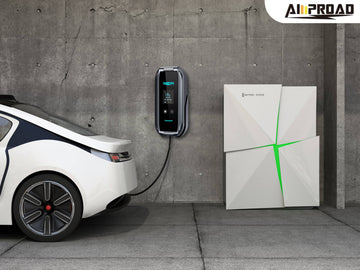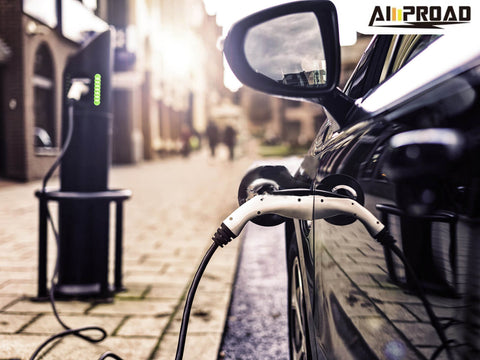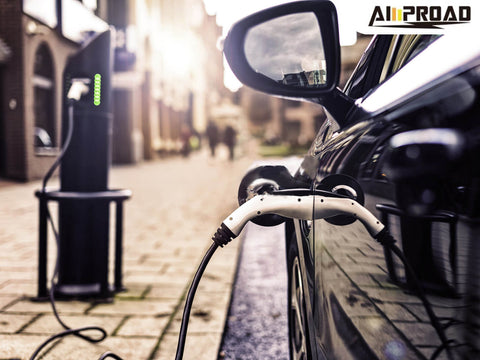
Understanding EV charging starts with the fundamentals of charger types, such as Level 1 and Level 2, which form the basis of a smooth charging experience. Knowing how power is transferred step by step ensures both safety and efficiency. Bringing charging to your home involves considering installation requirements and choosing a charger that suits specific needs. Weighing factors like speed, compatibility, and cost helps in making an informed decision for a hassle-free charging routine.
What Is An EV Charger?
Electric vehicles (EVs) have become emblematic of the global shift toward sustainable and eco-friendly transportation. At the heart of this transition lies a critical component—Electric Vehicle Chargers. This section provides an in-depth exploration of what an EV charger is, its purpose, the various types available, and the paramount importance of comprehending their role in the broader context of electric vehicles.
An Electric Vehicle Charger is a device designed to supply electric energy to recharge electric vehicles. Much like a fuel pump for traditional vehicles, an EV charger is the lifeline that replenishes the energy storage system within an electric vehicle, typically its battery. The primary purpose of an EVSE charger is to facilitate the charging process, ensuring that EVs remain operational and ready for use.
These chargers function as the interface between the power grid and the electric vehicle, managing the flow of electricity to the vehicle's battery in a controlled and efficient manner. The process involves converting alternating current (AC) from the grid into direct current (DC) suitable for the vehicle's battery, allowing for the storage of electrical energy.
EV home charger come in various types, each catering to different charging needs and usage scenarios. Understanding the distinctions among these types is essential for both EV owners and the broader electric mobility infrastructure. The three primary types of EV chargers are:
Level 1 Chargers: These chargers operate on a standard household electrical outlet and are characterized by a voltage of 120 volts. Level 1 charger is common in residential settings and are often included with the purchase of an electric vehicle. While they offer slower charging speeds, they are convenient for overnight charging.
Level 2 Chargers: Operating at a higher voltage of 240 volts, Level 2 charger delivers faster charging times compared to Level 1. They are suitable for various scenarios, including workplace charging stations and public charging networks. Level 2 chargers cater to a more diverse range of charging needs and contribute to the expanding accessibility of EV charging stations infrastructure.

DC Fast Chargers: This high-powered charging solution operates at even higher voltages, typically above 400 volts. DC fast chargers significantly reduce charging times, making them ideal for on-the-go charging. They are commonly found along highways and in locations where quick turnaround times are crucial.
Each type of charger serves a specific purpose in the EV charging landscape, providing users with options that align with their charging needs and lifestyle.
Understanding the role of EV chargers is paramount in the context of electric vehicles for several compelling reasons. Firstly, it empowers consumers to make informed decisions when choosing an electric vehicle and associated charging infrastructure. Knowing the capabilities and limitations of different chargers allows users to align their choices with their daily routines and charging preferences.
Additionally, as the adoption of electric vehicles continues to rise, a comprehensive understanding of EV car charger becomes crucial for the development and expansion of charging infrastructure. Governments, businesses, and communities need to strategically plan the deployment of charging stations to ensure widespread accessibility and convenience for EV owners.
And, comprehending the role of EV chargers is integral to dispelling range anxiety—the fear of running out of battery power before reaching a charging station. By understanding the charging capabilities of different chargers, users can plan their journeys and charging stops more effectively, contributing to a seamless and positive EV ownership experience.
How Does EV Charging Work?
Electric Vehicle (EV) charging, though seemingly straightforward, involves a series of intricate processes that ensure the seamless transfer of energy from the power grid to an EV's battery. This section provides a detailed exploration of how EV charging works, covering the initial connection and authentication processes, communication between the vehicle and charging station, and the intricacies of power transfer and conversion.
Initial Connection and Authentication Processes
The journey of EV charging begins with the initial connection of the electric vehicle to the charging station. This process is akin to refueling a traditional vehicle but involves plugging the EV into the charging station. However, to ensure security and control access to the charging infrastructure, authentication mechanisms come into play.
Authentication is a crucial aspect of electric vehicle charging, as it prevents unauthorized use of the charging station and ensures that only authorized users can access the electrical energy. Various methods, including RFID cards, mobile apps, or key fobs, are employed for authentication. Users need to authenticate themselves through these mechanisms to initiate the charging process, promoting secure and controlled access to the charging infrastructure.
Communication Between the Vehicle and Charging Station
Once the EV is plugged in and authenticated, communication between the vehicle and the charging station takes center stage. This communication is facilitated by standardized protocols that allow for the exchange of information between the two entities, ensuring compatibility and safety throughout the charging process.
Several communication protocols are employed in the EVSE charger ecosystem. Common standards include CHAdeMO, CCS (Combined Charging System), and Tesla's proprietary Supercharger protocol. These protocols enable the vehicle and charging station to communicate effectively, confirming parameters such as the maximum charging power the vehicle can accept and the state of charge of the battery.

The information exchange is crucial for optimizing the charging process. For example, the charging station needs to know the state of the EV's battery, and the vehicle needs information about the charging station's capabilities. This bidirectional communication ensures that charging occurs at the optimal rate and within the safety limits of the EV's battery and the charging infrastructure.
Power Transfer and Conversion
Once the initial connection is established, authentication is completed, and communication protocols are synchronized, the actual transfer of power begins. This involves the conversion of alternating current (AC) from the power grid to direct current (DC) suitable for charging the vehicle's battery.
Charging stations use power electronics to convert AC to DC, a process known as rectification. This conversion is necessary because most electric vehicle batteries, especially lithium-ion batteries, operate on DC. The charging station manages this conversion to provide the appropriate form of energy that the vehicle's battery can store.
The mechanisms and rates of power transfer vary depending on the type of charger. Level 1 and Level 2 chargers, which are commonly found in residential and commercial settings, deliver power at different rates. Level 1 chargers typically have a power output of around 1.4 kilowatts (kW), whereas Level 2 chargers can range from 3.3 kW to 19.2 kW. DC fast chargers, found in more public and high-traffic areas, can deliver much higher power, often exceeding 50 kW and, in some cases, reaching 350 kW.
The rate of power transfer is a critical factor in determining how quickly an EV can charge. While Level 1 chargers are suitable for overnight charging, Level 2 chargers offer faster charging times, and DC fast chargers are designed for rapid charging on the go.
How Setup Home EV Charger?
Setting up a home Electric Vehicle (EV) charger is a pivotal step toward embracing the convenience and sustainability of electric transportation. This section guides you through the considerations for installation and the features and options available for home EV charger.
Considerations for Installing a Home EV Charging Station
Before diving into the installation process, it's essential to assess your home's electrical infrastructure. Most electric vehicles come with Level 1 chargers that can plug into a standard 120-volt household outlet. However, for faster charging, you might consider a Level 2 charger including the level 2 portable EVSE, which typically requires a 240-volt outlet. It's crucial to determine the compatibility of your home's electrical system with the chosen charging station.
The level 2 EV charger installation process involves mounting the charging station, connecting it to the power supply, and configuring any necessary settings. While many installations are straightforward, potential challenges may arise, such as the need for electrical upgrades or the installation of a dedicated circuit. In such cases, consulting with a qualified electrician ensures a smooth and safe installation process.

Home Charging Station Features and Options
Home EV charging stations come in two primary types: Level 1 and Level 2, each offering distinct features and options to cater to individual needs.
Level 1 Chargers: These chargers are convenient for residential use, requiring only a standard 120-volt household outlet. Level 1 chargers are often included with the purchase of an electric vehicle, making them a cost-effective option. While they provide a slower charging rate, they are suitable for overnight charging, ensuring your EV is ready for daily use.
Level 2 Chargers: If you seek faster charging times, an EV charger level 2 is a compelling choice. These chargers operate at 240 volts, delivering a higher power output and significantly reducing charging times compared to Level 1. They are ideal for homeowners who require quicker turnaround times and have the electrical infrastructure to support a higher voltage outlet.
Choosing the right charging station depends on your individual needs and preferences. If you primarily use your electric vehicle for daily commuting and have the luxury of leaving it plugged in overnight, a Level 1 charger may suffice. On the other hand, if you have a more dynamic schedule or multiple EVs in the household, a Level 2 EV charger offers the flexibility and speed you need.
Consider additional features such as smart charging capabilities, which allow you to monitor and control charging remotely. Some charging stations offer connectivity with mobile apps, enabling you to schedule charging times, track energy usage, and receive notifications—all contributing to a more seamless and personalized charging experience.
How to Choose the Right EV Home Charger?
Choosing the ideal EV home charger involves evaluating several factors to ensure a cost-effective and efficient charging solution.
Factors Influencing Charger Selection
Consider the charging speed offered by Level 1 and Level 2 chargers. Level 2 chargers generally provide faster charging times, making them suitable for users with more demanding charging needs.
Ensure that the chosen charger is compatible with your electric vehicle model. Different EVs have varying charging specifications, and a compatible charger ensures optimal performance.

Cost Considerations and Available Incentives
Evaluate the upfront costs of the chargers against the long-term benefits they offer. While Level 1 chargers are often more affordable initially, Level 2 chargers might present better long-term value due to faster charging capabilities.
Explore available government incentives and rebates for EV home charging installations. Many regions offer financial incentives to promote the adoption of electric vehicles and their associated charging infrastructure.
Consider the Amproad Level 1 and Level 2 EV chargers as a cost-effective solution. With competitive upfront costs, these chargers offer an efficient and reliable charging experience for various electric vehicle models. Their user-friendly design and compatibility with standard electrical outlets make them a convenient choice for home charging.
Future-Proofing Considerations
Consider the evolving landscape of EV charging technology. While Level 2 chargers are currently prevalent, keep an eye on emerging advancements to ensure your chosen charger remains compatible with future electric vehicle standards.
Future-proof your charging setup by selecting a charger that aligns with evolving EV standards. This ensures that your charging infrastructure remains relevant and efficient as electric vehicle technology continues to progress.
As a final point,, the decision-making process for selecting a home EV charger involves a careful balance of charging speed, compatibility, costs, and future-proofing considerations. The Amproad Level 1 and Level 2 chargers offer a cost-effective solution with features designed to meet the needs of diverse electric vehicle users, making them a worthy consideration in the quest for an optimal home charging experience.


